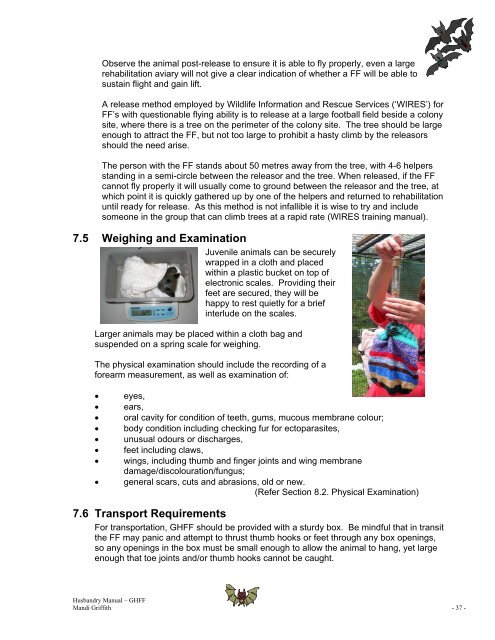Husbandry Manual for Grey- Headed Flying Fox - Nswfmpa.org
Husbandry Manual for Grey- Headed Flying Fox - Nswfmpa.org
Husbandry Manual for Grey- Headed Flying Fox - Nswfmpa.org
Create successful ePaper yourself
Turn your PDF publications into a flip-book with our unique Google optimized e-Paper software.
Observe the animal post-release to ensure it is able to fly properly, even a large<br />
rehabilitation aviary will not give a clear indication of whether a FF will be able to<br />
sustain flight and gain lift.<br />
A release method employed by Wildlife In<strong>for</strong>mation and Rescue Services (‘WIRES’) <strong>for</strong><br />
FF’s with questionable flying ability is to release at a large football field beside a colony<br />
site, where there is a tree on the perimeter of the colony site. The tree should be large<br />
enough to attract the FF, but not too large to prohibit a hasty climb by the releasors<br />
should the need arise.<br />
The person with the FF stands about 50 metres away from the tree, with 4-6 helpers<br />
standing in a semi-circle between the releasor and the tree. When released, if the FF<br />
cannot fly properly it will usually come to ground between the releasor and the tree, at<br />
which point it is quickly gathered up by one of the helpers and returned to rehabilitation<br />
until ready <strong>for</strong> release. As this method is not infallible it is wise to try and include<br />
someone in the group that can climb trees at a rapid rate (WIRES training manual).<br />
7.5 Weighing and Examination<br />
Juvenile animals can be securely<br />
wrapped in a cloth and placed<br />
within a plastic bucket on top of<br />
electronic scales. Providing their<br />
feet are secured, they will be<br />
happy to rest quietly <strong>for</strong> a brief<br />
interlude on the scales.<br />
Larger animals may be placed within a cloth bag and<br />
suspended on a spring scale <strong>for</strong> weighing.<br />
The physical examination should include the recording of a<br />
<strong>for</strong>earm measurement, as well as examination of:<br />
• eyes,<br />
• ears,<br />
• oral cavity <strong>for</strong> condition of teeth, gums, mucous membrane colour;<br />
• body condition including checking fur <strong>for</strong> ectoparasites,<br />
• unusual odours or discharges,<br />
• feet including claws,<br />
• wings, including thumb and finger joints and wing membrane<br />
damage/discolouration/fungus;<br />
• general scars, cuts and abrasions, old or new.<br />
(Refer Section 8.2. Physical Examination)<br />
7.6 Transport Requirements<br />
For transportation, GHFF should be provided with a sturdy box. Be mindful that in transit<br />
the FF may panic and attempt to thrust thumb hooks or feet through any box openings,<br />
so any openings in the box must be small enough to allow the animal to hang, yet large<br />
enough that toe joints and/or thumb hooks cannot be caught.<br />
<strong>Husbandry</strong> <strong>Manual</strong> – GHFF<br />
Mandi Griffith - 37 -

















